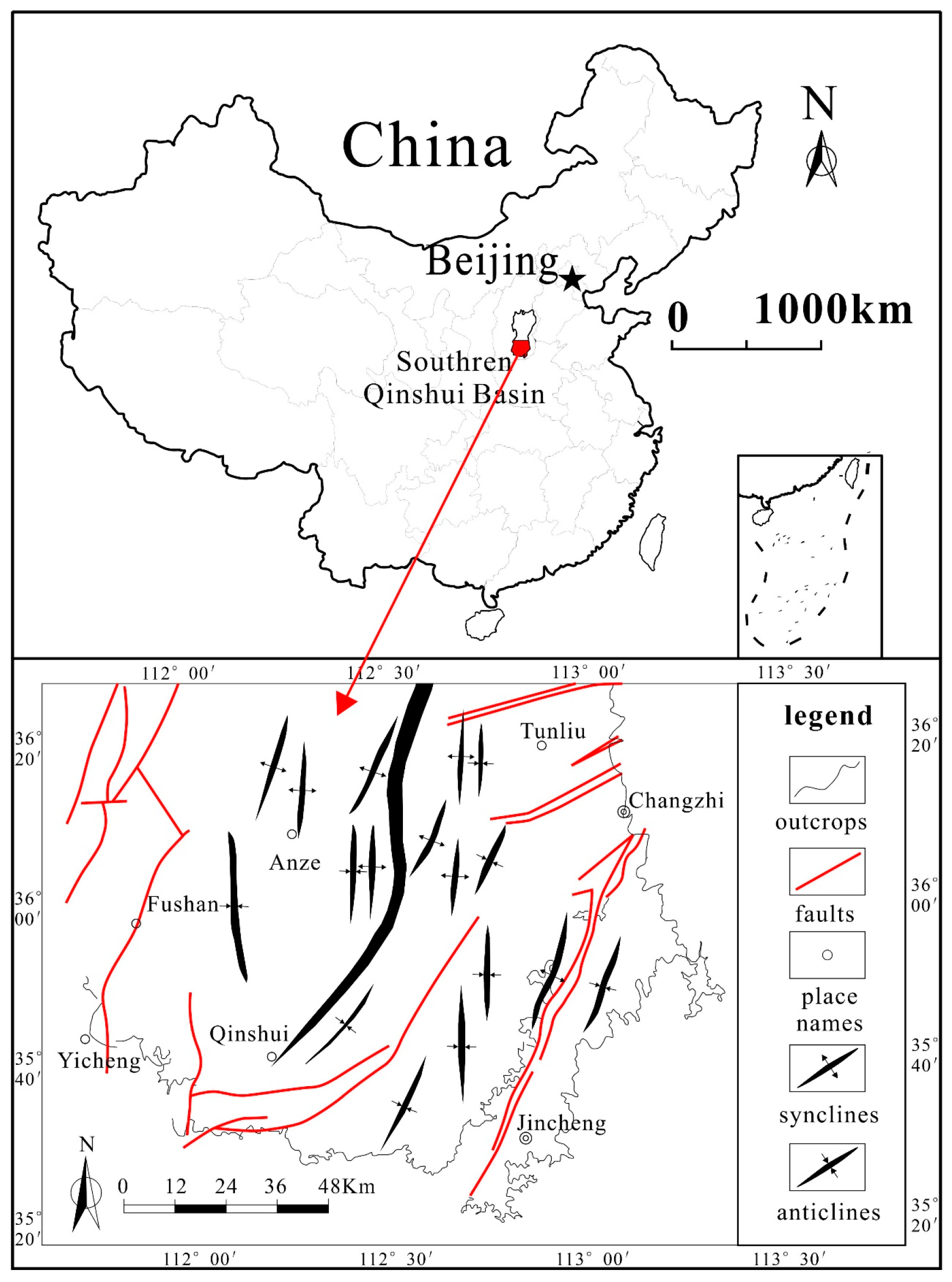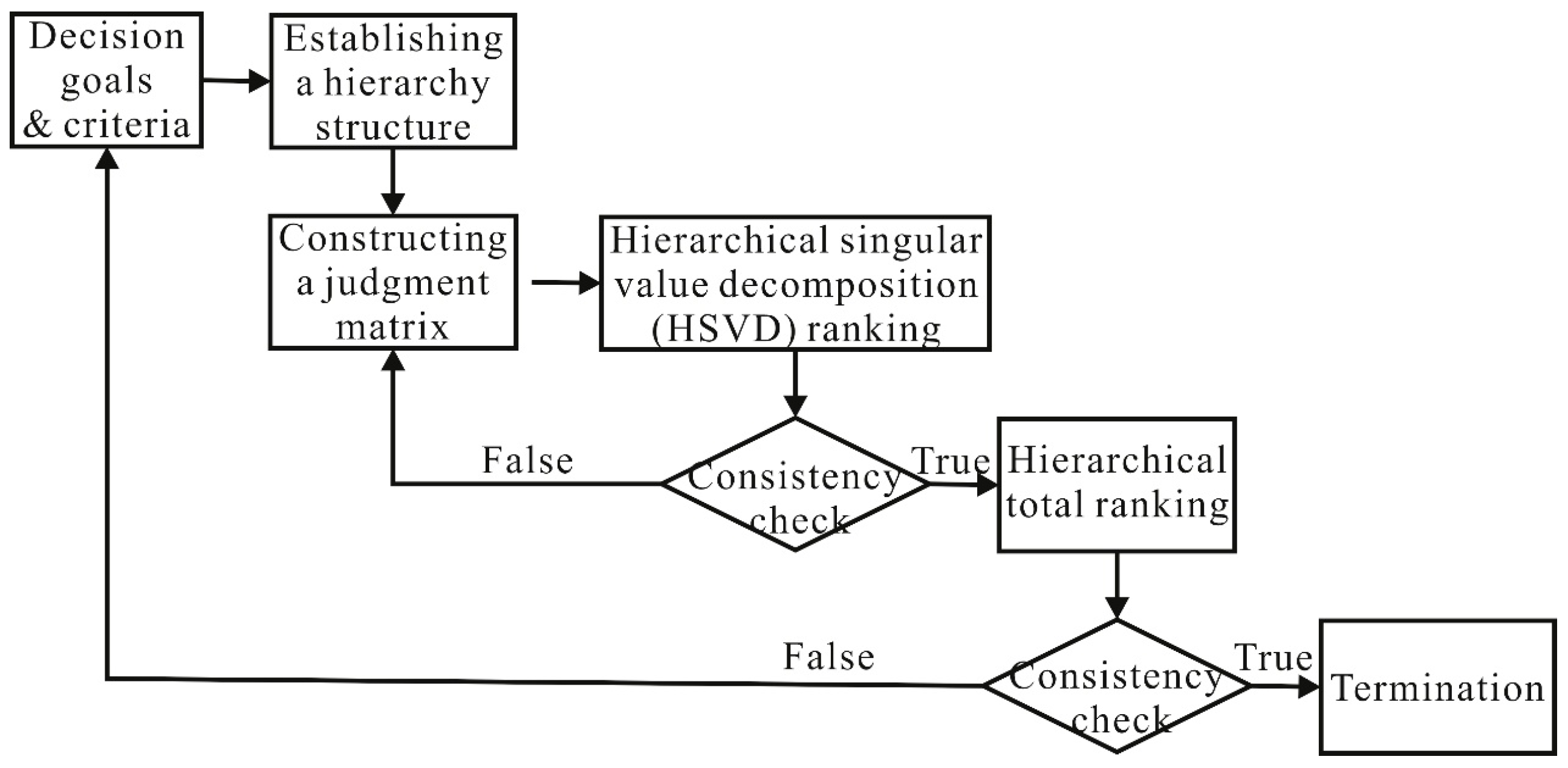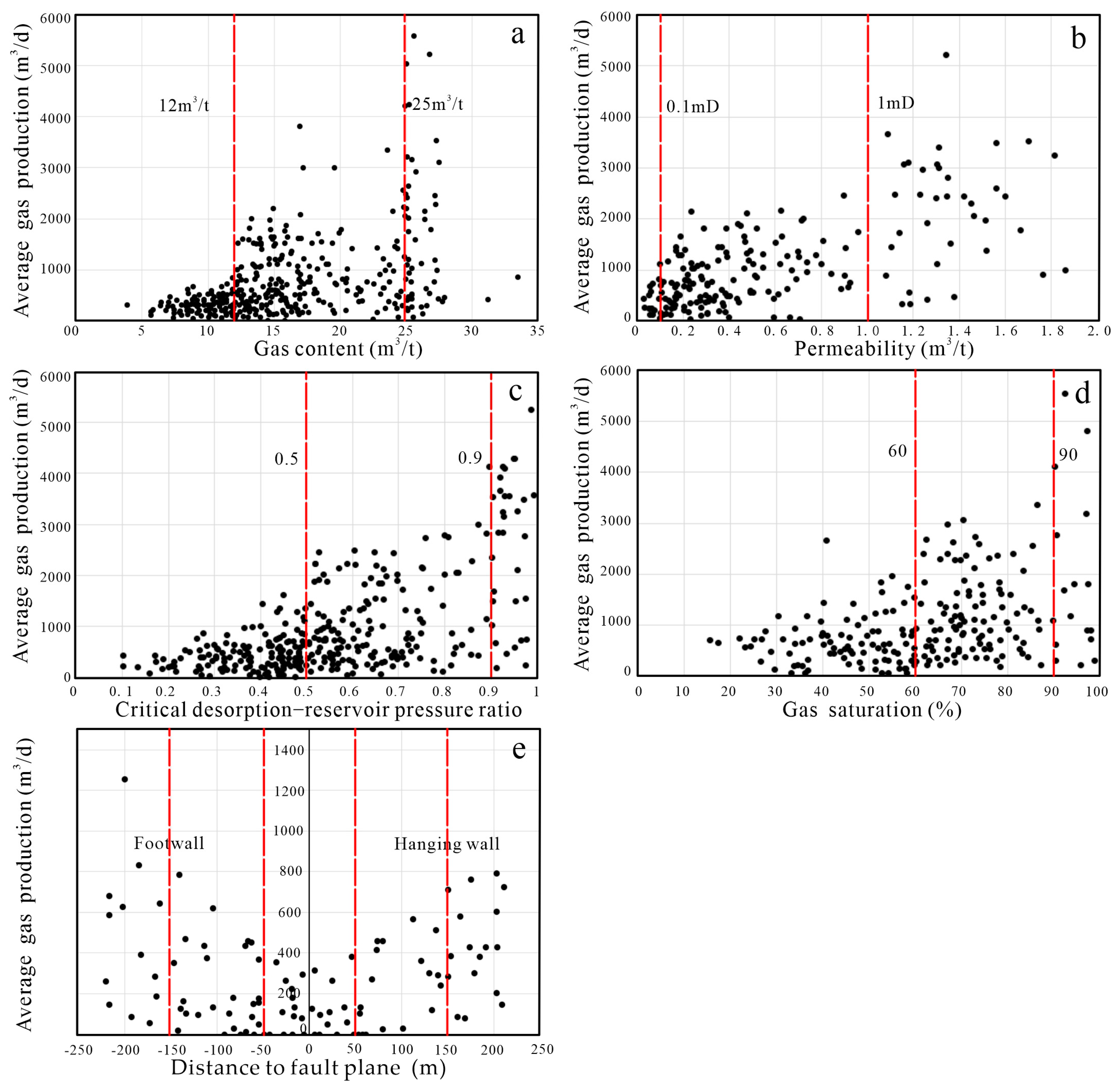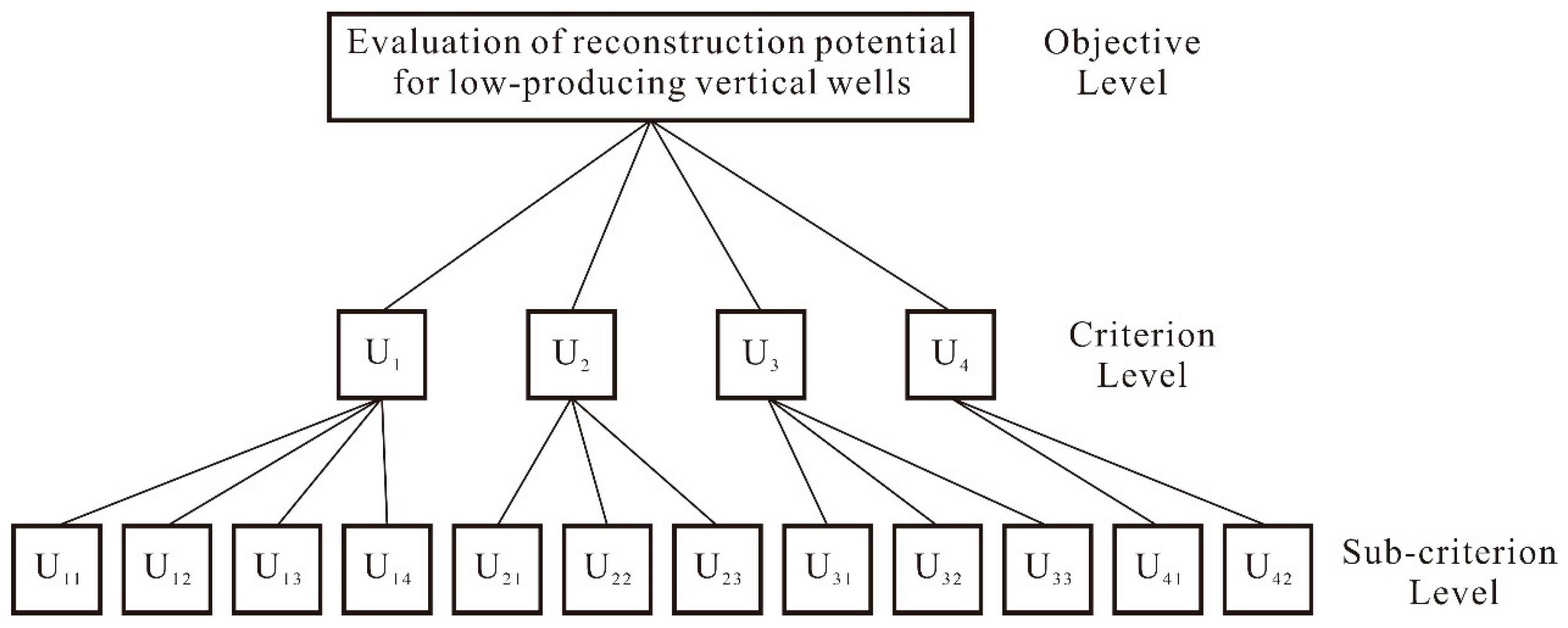Evaluation of Reconstruction Potential for Low-Production Vertical Wells of CBM in the Southern Qinshui Basin
Abstract
:1. Introduction
2. Research Method
2.1. AHP Model for Determination of Weights of Each Evaluation Index
2.2. The Gray Correlation Analysis Method
- (1)
- Determine the comparison sequence and reference sequence
- (2)
- Normalization of data
- (3)
- Calculation of correlation coefficient
- (4)
- Calculation of correlation degree
3. The Factors Controlling the Production of CBM
3.1. Coal Reservoir Characteristics
- (1)
- Gas Content
- (2)
- Gas Saturation
- (3)
- Critical desorption–reservoir pressure ratio and recoverable coefficient
- (4)
- Coal seam thickness
- (5)
- Permeability
- (6)
- Geological Structure
- (7)
- In situ Stress
- (8)
- Reservoir Pressure
- (9)
- Coal texture
3.2. Engineering and Drainage Techniques
- (1)
- Drilling engineering
- (2)
- Fracturing engineering
- (3)
- Drainage technology
- (4)
- Water production
4. Results and Discussion
4.1. Evaluation Index
4.2. Determination of Weights for Each Evaluation Index (AHP Model)
4.3. Gray Correlation Degree
5. Conclusions
- (1)
- Through extensive data analysis and field practical experience, the evaluation of reconstruction potential for low-production wells in the southern Qinshui Basin focuses on geological conditions and the degree of damage caused by initial fracturing to the coal reservoir. For this purpose, a comprehensive set of 12 indicators and their corresponding grading standards have been established to evaluate the reconstruction potential. These indicators encompass crucial factors, such as gas content, coal seam thickness, recoverable coefficient, distance to structure, critical desorption–reservoir pressure ratio, gas saturation, coal texture, permeability, pressure gradient, burial depth, water production rate, and reservoir damage ratio.
- (2)
- The weights for each evaluation indicator were obtained using the Analytic Hierarchy Process (AHP). The results indicate that the gas content has the highest weight, with a value of 0.15. On the other hand, the recovery coefficient has the lowest weight, with a value of 0.03. The weights for the remaining indicators fall between these two values, reflecting their relative importance in the evaluation process.
- (3)
- The reconstruction potential of five wells was evaluated using the gray correlation analysis method. The results indicate that candidate wells 1, 4, and 5 have high reconstruction potential, candidate well 2 has a moderate reconstruction potential, and candidate well 3 has a low reconstruction potential.
- (4)
- The developed evaluation method for reconstruction potential is primarily applicable to the Qinshui Basin. Due to significant differences in geological characteristics and coal reservoir conditions in other regions, the applicability of this evaluation method in other areas requires further research and validation.
Author Contributions
Funding
Institutional Review Board Statement
Informed Consent Statement
Data Availability Statement
Conflicts of Interest
References
- Mastalerz, M.; Drobniak, A. 5–Coalbed Methane: Reserves, Production, and Future Outlook. In Future Energy, 3rd ed.; Elsevier: Amsterdam, The Netherlands, 2020; pp. 97–109. [Google Scholar] [CrossRef]
- Wen, S.; Zhou, K.; Lu, Q. A discussion on CBM development strategies in China: A case study of PetroChina Coalbed Methane Co., Ltd. Nat. Gas Ind. B 2019, 6, 610–618. [Google Scholar] [CrossRef]
- Gilman, A.; Beckie, R. Flow of Coal-Bed Methane to a Gallery. Transp. Porous Media 2000, 41, 1–16. [Google Scholar] [CrossRef]
- Altowilib, A.; AlSaihati, A.; Alhamood, H.; Alafnan, S.; Alarifi, S. Reserves Estimation for Coalbed Methane Reservoirs: A Review. Sustainability 2020, 12, 10621. [Google Scholar] [CrossRef]
- Mu, F.; Zhong, W.; Zhao, X.; Che, C.; Chen, Y.; Zhu, J.; Wang, B. Strategies for the development of CBM gas industry in China. Nat. Gas Ind. B 2015, 2, 383–389. [Google Scholar] [CrossRef] [Green Version]
- Bosikov, I.I.; Martyushev, N.V.; Klyuev, R.V.; Savchenko, I.A.; Kukartsev, V.V.; Kukartsev, V.A.; Tynchenko, Y.A. Modeling and Complex Analysis of the Topology Parameters of Ventilation Networks When Ensuring Fire Safety While Developing Coal and Gas Deposits. Fire 2023, 6, 95. [Google Scholar] [CrossRef]
- Zou, Q.; Chen, Z.; Cheng, Z.; Liang, Y.; Xu, W.; Wen, P.; Zhang, B.; Liu, H.; Kong, F. Evaluation and intelligent deployment of coal and coalbed methane coupling coordinated exploitation based on Bayesian network and cuckoo search. Int. J. Min. Sci. Technol. 2022, 32, 1315–1328. [Google Scholar] [CrossRef]
- Pashin, J.C. Variable gas saturation in coalbed methane reservoirs of the Black Warrior Basin: Implications for exploration and production. Int. J. Coal Geol. 2010, 82, 135–146. [Google Scholar] [CrossRef]
- Liang, W.; Yan, J.; Zhang, B.; Hou, D. Review on Coal Bed Methane Recovery Theory and Technology: Recent Progress and Perspectives. Energy Fuels 2021, 35, 4633–4643. [Google Scholar] [CrossRef]
- Zhu, Q.; Zuo, Y.; Yang, Y. How to solve the technical problems in CBM development: A case study of a CBM gas reservoir in the southern Qinshui Basin. Nat. Gas Ind. B 2015, 2, 277–281. [Google Scholar] [CrossRef] [Green Version]
- Tao, S.; Tang, D.; Xu, H.; Gao, L.; Fang, Y. Factors controlling high-yield coalbed methane vertical wells in the Fanzhuang Block, Southern Qinshui Basin. Int. J. Coal Geol. 2014, 134–135, 38–45. [Google Scholar] [CrossRef]
- Karacan, C.Ö. Production history matching to determine reservoir properties of important coal groups in the Upper Pottsville formation, Brookwood and Oak Grove fields, Black Warrior Basin, Alabama. J. Nat. Gas Sci. Eng. 2013, 10, 51–67. [Google Scholar] [CrossRef] [Green Version]
- Peng, C.; Zou, C.; Zhou, T.; Li, K.; Yang, Y.; Zhang, G.; Wang, W. Factors affecting coalbed methane (CBM) well productivity in the Shizhuangnan block of southern Qinshui basin, North China: Investigation by geophysical log, experiment and production data. Fuel 2017, 191, 427–441. [Google Scholar] [CrossRef]
- Li, Z.; Liu, D.; Wang, Y.; Si, G.; Cai, Y.; Wang, Y. Evaluation of multistage characteristics for coalbed methane desorption-diffusion and their geological controls: A case study of the northern Gujiao Block of Qinshui Basin, China. J. Pet. Sci. Eng. 2021, 204, 108704. [Google Scholar] [CrossRef]
- Zhang, P.; Meng, Z.; Jiang, S.; Chen, X. Characteristics of in-situ stress distribution in Zhengzhuang Region, Southern Qinshui Basin, China and its stress path during depletion. Eng. Geol. 2020, 264, 105413. [Google Scholar] [CrossRef]
- Yang, G.; Tang, S.; Hu, W.; Song, Z.; Zhang, S.; Xi, Z.; Wang, K.; Yan, X. Analysis of abnormally high water production in coalbed methane vertical wells: A case study of the Shizhuangnan block in the southern Qinshui Basin, China. J. Pet. Sci. Eng. 2020, 190, 107100. [Google Scholar] [CrossRef]
- Wang, Q.; Su, X.; Su, L.; Zhou, F. CBM geological characteristics and exploration potential in the Sunan Syncline block, southern north China basin. J. Pet. Sci. Eng. 2020, 186, 106713. [Google Scholar] [CrossRef]
- Zhao, L.; Chen, X.; Zou, H.; Liu, P.; Liang, C.; Zhang, N.; Li, N.; Luo, Z.; Du, J. A review of diverting agents for reservoir stimulation. J. Pet. Sci. Eng. 2020, 187, 106734. [Google Scholar] [CrossRef]
- Huang, Q.; Liu, S.; Wang, G.; Wu, B.; Zhang, Y. Coalbed methane reservoir stimulation using guar-based fracturing fluid: A review. J. Nat. Gas Sci. Eng. 2019, 66, 107–125. [Google Scholar] [CrossRef]
- Keshavarz, A.; Badalyan, A.; Johnson, R.; Bedrikovetski, P. Improving the efficiency of hydraulic fracturing treatment in CBM reservoirs by stimulating the surrounding natural fracture system. APPEA J. 2015, 55, 351–360. [Google Scholar] [CrossRef]
- Keshavarz, A.; Badalyan, A.; Carageorgos, T.; Bedrikovetsky, P.; Johnson, R., Jr. Stimulation of coal seam permeability by micro-sized graded proppant placement using selective fluid properties. Fuel 2015, 144, 228–236. [Google Scholar] [CrossRef]
- Sampath, K.H.S.M.; Perera, M.S.A.; Ranjith, P.G.; Matthai, S.K.; Rathnaweera, T.; Zhang, G.; Tao, X. CH4–CO2 gas exchange and supercritical CO2 based hydraulic fracturing as CBM production-accelerating techniques: A review. J. CO2 Util. 2017, 22, 212–230. [Google Scholar] [CrossRef]
- Danesh, N.N.; Zhao, Y.; Teng, T.; Masoudian, M.S. Prediction of interactive effects of CBM production, faulting stress regime, and fault in coal reservoir: Numerical simulation. J. Nat. Gas Sci. Eng. 2022, 99, 104419. [Google Scholar] [CrossRef]
- Basak, I.; Saaty, T. Group decision making using the analytic hierarchy process. Math. Comput. Model. 1993, 17, 101–109. [Google Scholar] [CrossRef]
- Ni, X.; Tan, X.; Wang, B.; Fu, X. An evaluation method for types of low-production coalbed methane reservoirs and its application. Energy Rep. 2021, 7, 5305–5315. [Google Scholar] [CrossRef]
- Yao, Y.; Liu, D.; Tang, D.; Huang, W.; Tang, S.; Chen, Y. A Comprehensive Model for Evaluating Coalbed Methane Reservoirs in China. Acta Geol. Sin. Engl. Ed. 2010, 82, 1253–1270. [Google Scholar] [CrossRef]
- Yao, Y.; Liu, D.; Tang, D.; Tang, S.; Che, Y.; Huang, W. Preliminary evaluation of the coalbed me-thane production potential and its geological controls in the Weibei Coalfield, southeastern Ordos Basin, China. Int. J. Coal Geol. 2009, 78, 1–15. [Google Scholar] [CrossRef]
- Cai, Y.; Liu, D.; Yao, Y.; Li, J.; Qiu, Y. Geological controls on prediction of coalbed methane of No. 3 coal seam in Southern Qinshui Basin, North China. Int. J. Coal Geol. 2011, 88, 101–112. [Google Scholar] [CrossRef]
- Tapia, J.F.D.; Promentilla, M.A.B.; Tseng, M.-L.; Tan, R.R. Screening of carbon dioxide utilization options using hybrid Analytic Hierarchy Process-Data Envelopment Analysis method. J. Clean. Prod. 2017, 165, 1361–1370. [Google Scholar] [CrossRef]
- Lin, S.J.; Lu, I.J.; Lewis, C. Grey relation performance correlations among economics, energy use and carbon dioxide emission in Taiwan. Energy Policy 2017, 35, 1948–1955. [Google Scholar] [CrossRef]
- Wang, J.J.; Jing, Y.Y.; Zhang, C.F.; Zhang, X.T.; Shi, G.-H. Integrated evaluation of distributed triple-generation systems using improved grey incidence approach. Energy 2008, 33, 1427–1437. [Google Scholar] [CrossRef]
- ASLAN, N. Use of the grey analysis to determine optimal oil agglomeration with multiple performance characteristics. Fuel 2013, 109, 109373–109378. [Google Scholar] [CrossRef]
- Kiani, A.; Sakurovs, R.; Grigore, M.; Sokolova, A. Gas sorption capacity, gas sorption rates and nanoporosity in coals. Int. J. Coal Geol. 2018, 200, 77–86. [Google Scholar] [CrossRef]
- Salmachi, A.; Yarmohammadtooski, Z. Production data analysis of coalbed methane wells to estimate the time required to reach to peak of gas production. Int. J. Coal Geol. 2015, 141–142, 33–41. [Google Scholar] [CrossRef]
- Pillalamarry, M.; Harpalani, S.; Liu, S. Gas diffusion behavior of coal and its impact on production from coalbed methane reservoirs. Int. J. Coal Geol. 2011, 86, 342–348. [Google Scholar] [CrossRef]
- Li, P.; Zhang, X.; Li, J.; Zhao, J.; Huang, J.; Zhang, S.; Zhou, S. Analysis of the Key Factors Affecting the Productivity of Coalbed Methane Wells: A Case Study of a High-Rank Coal Reservoir in the Central and Southern Qinshui Basin, China. ACS Omega 2020, 5, 28012–28026. [Google Scholar] [CrossRef]
- Chen, S.; Tao, S.; Tian, W.; Tang, D.; Zhang, B.; Liu, P. Hydrogeological control on the accumulation and production of coalbed methane in the Anze Block, southern Qinshui Basin, China. J. Pet. Sci. Eng. 2021, 198, 108138. [Google Scholar] [CrossRef]
- Sun, F.; Wang, B.; Li, M.; Liang, H. Major geological factors controlling the enrichment and high yield of coalbed methane in the southern Qinshui Basin. Acta Pet. Sin. 2014, 35, 1070–1079. [Google Scholar] [CrossRef]
- Tao, S.; Pan, Z.; Tang, S.; Chen, S. Current status and geological conditions for the applicability of CBM drilling technologies in China: A review. Int. J. Coal Geol. 2018, 202, 95–108. [Google Scholar] [CrossRef]
- Wang, H.; Yao, Y.; Liu, D.; Cai, Y.; Yang, Y.; Zhou, S. Determination of the degree of coal deformation and its effects on gas production in the southern Qinshui Basin, North China. J. Pet. Sci. Eng. 2022, 216, 110746. [Google Scholar] [CrossRef]
- Sang, S.; Liu, H.; Li, Y.; Li, M.; Li, L. Geological controls over coal-bed methane well production in southern Qinshui basin. Procedia Earth Planet. Sci. 2009, 1, 917–922. [Google Scholar] [CrossRef] [Green Version]
- Karthikeyan, G.; Chand, J.; Chatterjee, R. Impact of geomechanics in coal bed methane development and production, Barakar coals in central India. J. Pet. Sci. Eng. 2020, 194, 194107515. [Google Scholar] [CrossRef]
- Perera, M.S.A.; Ranjith, P.G.; Peter, M. Effects of saturation medium and pressure on strength parameters of Latrobe Valley brown coal: Carbon dioxide, water and nitrogen saturations. Energy 2011, 36, 6941–6947. [Google Scholar] [CrossRef]
- Zhou, R.; Zuo, Y.; Wang, Y.; Zhang, X.; Shuai, Z. Study on Optimization and evaluation indexes of coalbed methane development units in south of Qinshui Basin. In Proceedings of the 5th National Symposium on Efficient Development Technology of Natural Gas Reser, Nanchang, China, 1 March 2014. [Google Scholar]
- Zheng, A.; Wang, X.; Wang, X.; Wu, M.; Yuan, Y. The Effect of Coal Seam Gas saturation on CBM Well Productivity—A Case Study of Central Region of Hedong Area. Procedia Eng. 2011, 26, 1205–1213. [Google Scholar] [CrossRef] [Green Version]
- Han, S.-J.; Sang, S.-X.; Duan, P.-P.; Zhang, J.-C.; Xiang, W.-X.; Xu, A. The effect of the density difference between supercritical CO2 and supercritical CH4 on their adsorption capacities: An experimental study on anthracite in the Qinshui Basin. Pet. Sci. 2022, 19, 1516–1526. [Google Scholar] [CrossRef]
- Xiao, Z.; Wang, C.; Wang, G.; Jiang, Y.; Yu, J. An improved apparent permeability model considering full pore pressure range, variable intrinsic permeability and slippage coefficient. Int. J. Min. Sci. Technol. 2022, 32, 1233–1244. [Google Scholar] [CrossRef]
- Zhu, H.; Tang, X.; Liu, Q.; Liu, S.; Zhang, B.; Jiang, S.; McLennan, J.D. Permeability stress-sensitivity in 4D flow-geomechanical coupling of Shouyang CBM reservoir, Qinshui Basin, China. Fuel 2018, 232, 817–832. [Google Scholar] [CrossRef]
- Wupeng, Z.H.A.O.; Chunchun, L.I.U.; Xingwei, S.H.E.N.; He, P.E.N.G.; Hongtao, H.U.O. Study on the stimulation technologies for low-yield CBM wells in Zhengzhuang block. Oil Drill. Prod. Technol. 2017, 39, 491–494. [Google Scholar] [CrossRef]
- Meng, Z.; Zhang, J.; Wang, R. In-situ stress, pore pressure and stress-dependent permeability in the Southern Qinshui Basin. Int. J. Rock Mech. Min. Sci. 2011, 48, 122–131. [Google Scholar] [CrossRef]
- McMillan, D.W.; Palanyk, V.S. CBM: Fracture Stimulation—An Australian Experience. In Proceedings of the SPE Annual Technical Conference and Exhibition, Anaheim, CA, USA, 11–14 November 2007. [Google Scholar] [CrossRef]
- Jia, H.; Hu, Q.; Qi, K.; Liu, C.; Fan, B.; He, J. Reasons of low yield and stimulation measures for vertical CBM wells in high-rank coal. Coal Geology & Exploration. Coal Geol. Explor. 2019, 47, 104–110. [Google Scholar] [CrossRef]
- Zhang, L.; Shan, B.; Zhao, Y. Production performance laws of vertical wells by volume fracturing in CBM reservoirs. Nat. Gas Ind. B 2017, 4, 189–196. [Google Scholar] [CrossRef]
- Jamshidi, M.; Jessen, K. Water production in enhanced coalbed methane operations. J. Pet. Sci. Eng. 2012, 92–93, 56–64. [Google Scholar] [CrossRef]
- Ni, X.; Wang, Y.; Han, W.; Liu, D.; Li, Y.; Tao, C.; Gao, X.; Zhao, S. Division and application of development geological units for coalbed methane. J. China Coal Soc. 2020, 45, 2562–2574. [Google Scholar] [CrossRef]





| Primary Evaluation Factors | Secondary Evaluation Factors | Classification Standards | ||
|---|---|---|---|---|
| Low | Medium | High | ||
| Resources and geological structure (U1) | (U11) Gas content (m3/t) | ≤12 | 12–25 | ≥25 |
| (U12) Coal seam thickness (m) | ≤3 | 3–6 | ≥6 | |
| (U13) Recoverable coefficient (%) | ≤50 | 50–80 | ≥80 | |
| (U14) Distance to structure (m) | ≤50 | 50–150 | ≥150 | |
| Coal texture and gas saturation (U2) | (U21) Critical desorption–reservoir pressure ratio (%) | ≤0.5 | 0.5–0.9 | ≥0.9 |
| (U22) Gas saturation (%) | ≤60 | 60–90 | ≥90 | |
| (U23) * Coal texture (%) | ≥50 | 20–50 | ≤20 | |
| In situ stress and permeability (U3) | (U31) Permeability (mD) | ≤0.1 | 0.1–1 | ≥1 |
| (U32) Pressure Gradient (kPa/m) | ≤9.50 | 9.5–10 | ≥10 | |
| (U33) Burial depth (m) | ≥1000 | 500–1000 | ≤500 | |
| Reservoir damage and water production (U4) | (U41) Water production rate (m3/d) | ≥5 | 0.5–5 | ≤0.5 |
| (U42) Reservoir damage ratio (%) | ≥40 | 20–40 | ≤20 | |
| Intensity of Importance | Definition | Explanation |
|---|---|---|
| 1 | Equal Importance | Two indexes contribute equally to the objective |
| 2 | Weak or slight | |
| 3 | Moderate importance | Experience and judgement slightly favor one index over another |
| 4 | Moderate plus | |
| 5 | Strong importance | Experience and judgement strongly favor one index over another |
| 6 | Strong plus | |
| 7 | Very strong | An index is favored very strongly over another; its dominance demonstrated in practice |
| 8 | Very, very strong | |
| 9 | Extreme importance | The evidence favoring one index over another is of the highest possible order of affirmation |
| 1.1–1.9 | If the indexes are very close | May be difficult to assign the best value, but when compared with other contrasting indexes, the size of the small numbers would not be too noticeable, yet they can still indicate the relative importance of the indexes |
| Evaluation Indicators and Matrices | Eigenvector W | Maximum Eigenvalue λMAX | Random Consistency Ratio (CR) | |||||
|---|---|---|---|---|---|---|---|---|
| U | U1 | U2 | U3 | U4 | ||||
| U1 | 1 | 2 | 1 | 3 | 0.35 | 4.01 | 0.01 | |
| U2 | 0.5 | 1 | 2 | 2 | 0.28 | |||
| U3 | 1 | 0.5 | 1 | 3 | 0.26 | |||
| U4 | 0.33 | 0.5 | 0.33 | 1 | 0.11 | |||
| U1 | U11 | U12 | U13 | U14 | ||||
| U11 | 1 | 2 | 5 | 2 | 0.44 | 4.24 | 0.09 | |
| U12 | 0.5 | 1 | 3 | 2 | 0.28 | |||
| U13 | 0.2 | 0.33 | 1 | 0.33 | 0.08 | |||
| U14 | 0.5 | 0.5 | 3 | 1 | 0.20 | |||
| U2 | U21 | U22 | U23 | |||||
| U21 | 1 | 0.9 | 1 | 0.32 | 3.00 | 0 | ||
| U22 | 1.1 | 1 | 1.1 | 0.36 | ||||
| U23 | 1 | 0.9 | 1 | 0.32 | ||||
| U3 | U31 | U32 | U33 | |||||
| U31 | 1 | 0.83 | 0.83 | 0.29 | 3.00 | 0 | ||
| U32 | 1.2 | 1 | 1 | 0.36 | ||||
| U33 | 1.2 | 1 | 1 | 0.36 | ||||
| U4 | U41 | U42 | ||||||
| U41 | 1 | 1 | 0.5 | 2.00 | 0 | |||
| U42 | 1 | 1 | 0.5 | |||||
| Objective Level | Criterion Level | Weight | Sub-Criterion Level | Weight |
|---|---|---|---|---|
| Evaluation of transformation potential | Resources and geological structure (U1) | 0.35 | U11 | 0.15 |
| U12 | 0.10 | |||
| U13 | 0.03 | |||
| U14 | 0.07 | |||
| Coal texture and gas saturation (U2) | 0.28 | U21 | 0.09 | |
| U22 | 0.10 | |||
| U23 | 0.09 | |||
| In situ stress and permeability (U3) | 0.26 | U31 | 0.08 | |
| U32 | 0.09 | |||
| U33 | 0.09 | |||
| Reservoir damage and water production (U4) | 0.11 | U41 | 0.06 | |
| U42 | 0.06 |
| Matrix Order | 1 | 2 | 3 | 4 | 5 | 6 | 7 | 8 | 9 |
|---|---|---|---|---|---|---|---|---|---|
| RI | 0.00 | 0.00 | 0.58 | 0.9 | 1.12 | 1.24 | 1.32 | 1.41 | 1.42 |
| Well | U11 (m3/t) | U12 (m) | U13 (%) | U14 (m) | U21 | U22 (%) | U23 (%) | U31 (mD) | U32 (kPa/m) | U33 (m) | U41 (m3/d) | U42 (%) |
|---|---|---|---|---|---|---|---|---|---|---|---|---|
| 1 | 28 | 5.5 | 60 | 200 | 0.9 | 90 | 10 | 1.5 | 10 | 500 | 1 | 20 |
| 2 | 30 | 6.5 | 65 | 170 | 0.8 | 70 | 10 | 0.5 | 9 | 800 | 0.8 | 15 |
| 3 | 14 | 5.5 | 50 | 70 | 0.6 | 70 | 5 | 0.5 | 10 | 1000 | 6 | 20 |
| 4 | 28 | 5.5 | 75 | 45 | 0.9 | 80 | 5 | 0.5 | 5 | 800 | 0.5 | 40 |
| 5 | 27 | 5.5 | 85 | 210 | 0.8 | 90 | 0 | 1.5 | 18 | 600 | 0.5 | 25 |
| Candidate Well | Correlation Coefficient | Results | ||
|---|---|---|---|---|
| Low | Medium | High | ||
| 1 | 0.5248 | 0.5375 | 0.7735 | High |
| 2 | 0.5837 | 0.6300 | 0.6117 | Medium |
| 3 | 0.6245 | 0.6093 | 0.5743 | Low |
| 4 | 0.5848 | 0.6050 | 0.6487 | High |
| 5 | 0.5011 | 0.5512 | 0.7636 | High |
Disclaimer/Publisher’s Note: The statements, opinions and data contained in all publications are solely those of the individual author(s) and contributor(s) and not of MDPI and/or the editor(s). MDPI and/or the editor(s) disclaim responsibility for any injury to people or property resulting from any ideas, methods, instructions or products referred to in the content. |
© 2023 by the authors. Licensee MDPI, Basel, Switzerland. This article is an open access article distributed under the terms and conditions of the Creative Commons Attribution (CC BY) license (https://creativecommons.org/licenses/by/4.0/).
Share and Cite
Xue, K.; Sun, B.; Liu, C. Evaluation of Reconstruction Potential for Low-Production Vertical Wells of CBM in the Southern Qinshui Basin. Processes 2023, 11, 1741. https://doi.org/10.3390/pr11061741
Xue K, Sun B, Liu C. Evaluation of Reconstruction Potential for Low-Production Vertical Wells of CBM in the Southern Qinshui Basin. Processes. 2023; 11(6):1741. https://doi.org/10.3390/pr11061741
Chicago/Turabian StyleXue, Kaihong, Beilei Sun, and Chao Liu. 2023. "Evaluation of Reconstruction Potential for Low-Production Vertical Wells of CBM in the Southern Qinshui Basin" Processes 11, no. 6: 1741. https://doi.org/10.3390/pr11061741
APA StyleXue, K., Sun, B., & Liu, C. (2023). Evaluation of Reconstruction Potential for Low-Production Vertical Wells of CBM in the Southern Qinshui Basin. Processes, 11(6), 1741. https://doi.org/10.3390/pr11061741










